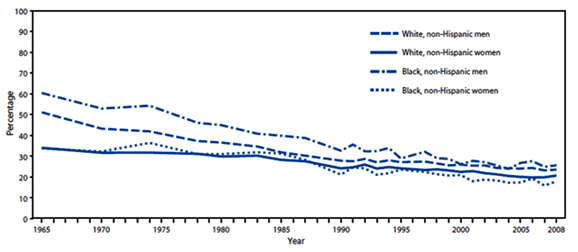Cigarette Smoking—United States, 1965–2008
This page is archived for historical purposes and is no longer being updated.
January 14, 2011 / Vol. 60 / No. 01 / pp. 109–13, Supplements
MMWR Highlights
Youth Data (2006–2008)
- Among youths aged 12–17 years, smoking was highest for:
- American Indian/Alaska Native females (17.8%)
- American Indian/Alaska Native males (16.7%)
- Non-Hispanic white females (12.4%)
- Non-Hispanic white males (11.3%)
- Among youths aged 12–17 years, smoking was lowest for:
- Asian females (2.9%)
- Asian males (5.2%)
- Non-Hispanic black females (5.6%)
- Non-Hispanic black males (6.1%).
Adult Data (2006–2008)
- Race/Ethnicity
- Among adults aged ≥18 years, smoking was highest for:
- American Indian/Alaska Native men (42.4%)
- American Indian/Alaska Native women (42.0%)
- Non-Hispanic black men (33.7%)
- Non-Hispanic white men (28.8%)
- Among adults aged ≥18 years, smoking was lowest for:
- Asian women (8.8%)
- Hispanic women (16.5%)
- Among adults aged ≥18 years, smoking was highest for:
- Age
- Persons aged 26–34 years and 35–49 years had the highest smoking rates (37.8% and 33.7%, respectively).
- Persons aged ≥65 years had the lowest smoking rate (9.4%).
- Income
- Persons whose household incomes were below the federal poverty thresholds (36.5%) or were at or near the thresholds (32.8%) had higher prevalence of smoking.
- Persons whose household incomes were above poverty levels had lower prevalence of smoking (22.5%).
- Education
- Smoking decreased with increasing levels of educational attainment.
- College graduates had the lowest prevalence of smoking (13.3%).
- Those having less than a high school education or only a high school diploma had the highest prevalence of smoking (32.0% and 29.3%, respectively).
- Employment Status
- Persons who were unemployed had a higher prevalence of smoking.
- Smoking prevalence among unemployed persons was 44.7%.
- Smoking prevalence among full-time employed persons was 27.8%.
Adult Data (1965–2008)
- Report findings demonstrated declines in smoking among white and black men and women aged 18 years or older. Findings also demonstrated the declining disparities between black and white men since the 1964 landmark Surgeon General's report on smoking and health (see figure below).

Tobacco Control
- Effective tobacco control strategies that can address disparities among specific populations include—
- increasing populations covered by comprehensive smoke-free policies (i.e., workplace, restaurants, and bars),
- increasing the price of tobacco products, coupled with evidence-based cessation services,
- reducing exposure to industry-targeted advertising, promotions, and sponsorships, and
- increasing the availability, accessibility, and effectiveness of tailored cessation services for populations affected by tobacco-related disparities.
- No single factor determines patterns of cigarette smoking and other tobacco use among vulnerable populations; rather, these are the results of complex interactions of multiple factors, such as:
- socioeconomic status
- cultural characteristics and acculturation
- biologic elements
- targeted advertising
- price of tobacco products
- varying capacities of communities to mount effective tobacco control initiatives
Background
- The National Survey on Drug Use and Health is sponsored by the Substance Abuse and Mental Health Services Administration and is designed to provide annual information about alcohol, tobacco, and illegal drug use among the noninstitutionalized U.S. household population aged ≥12 years.
- The National Health Interview Survey is administered annually by CDC's National Center for Health Statistics and is the principal source of information on the health of the civilian, noninstitutionalized, household population of the United States aged ≥18 years.
- Page last reviewed: March 29, 2011 (archived document)
- Content source:


 ShareCompartir
ShareCompartir